Every year there are reports of people getting lost in the snow and ice of winter. Mountain rescue callouts are predominantly about navigation errors. To make winter a safer place, it is a good idea to book a guide to lead or alternatively join a group heading out into the hills. Some groups are organised by companies on commercial trips, others are groups of friends or clubs. Nonetheless there is safety in numbers.
Every year there are winter wilderness expeditions running under the guidance of Andy Bateman of Scot Mountain Holidays in the Cairngorms and Glen Affric. There’s also usually a trip to Knoydart, home to Britain’s most remote pub; however there is a major reforestation project going on there this year which makes it less attractive to visit and all the accommodation will be taken by the forestry workers.
Life will be reduced to basics during the expedition and the only concerns will be: eat – sleep – hike (repeat). The perfect way to clear the mind and return feeling completely refreshed after only a few short days.
This is a rare opportunity to experience one of the remotest parts of the Cairngorms National Park at a time when the mountains are probably at their most glorious. The High Cairngorms are renowned for their wintry conditions yet at this time very few folk dare to do multi-day trips
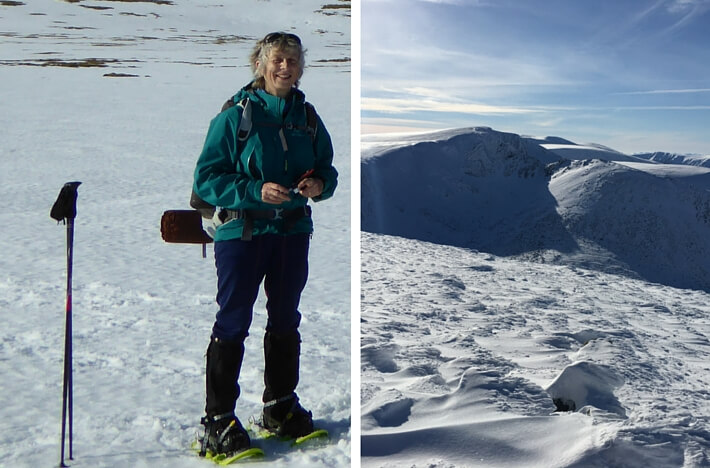
Celia enjoying her second (or third) winter expedition with Scot Mountain Holiadays
Highlights: winter skills, Monadh Mhor (Munro), Devil’s Point (Munro) Carn a’ Mhaim (Munro), Derry Cairngorm (Munro), Beinn a’ Chaorainn (Munro)
Price: £ on application
Email: SCO@scotmountainholidays.com for full information about this trip.
MINIMUM GROUP SIZE: 3 PEOPLE – Private dates available. Please enquire.
This is Scotland’s ultimate winter mountain journey. The high “plateau” route takes in Britain’s 2nd, 3rd, 4th and 5th highest peaks on a journey that circumnavigates Scotland’s finest and best known mountain pass, the Lairig Ghru.
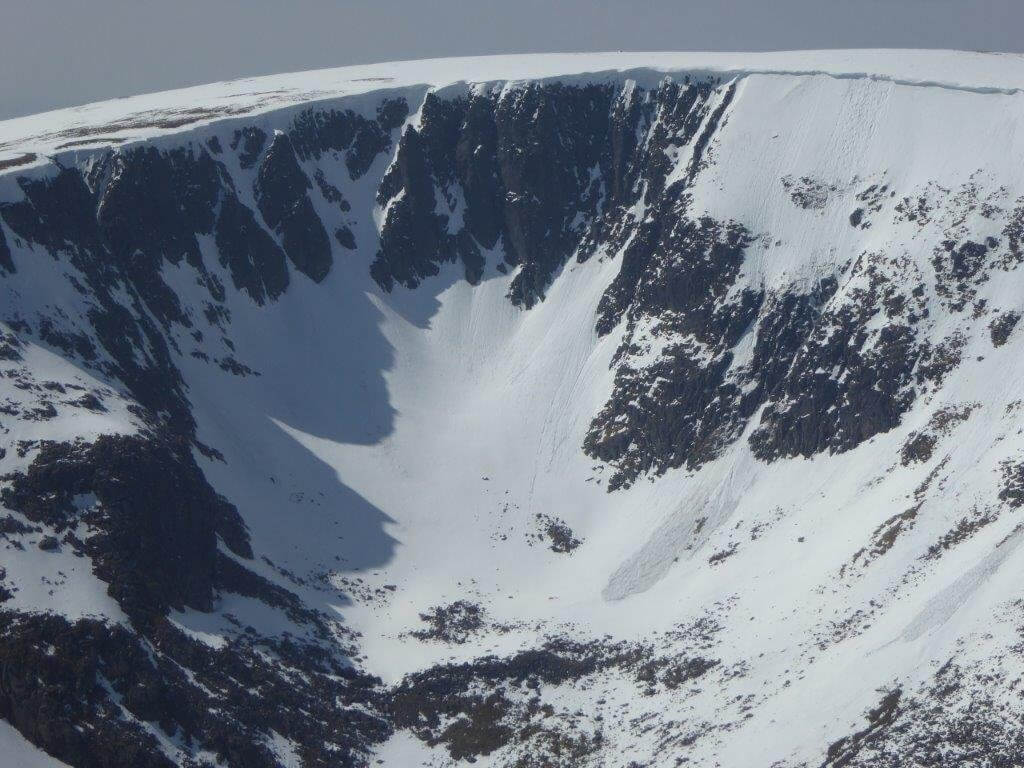
Check out the potential avalanche sites on the head wall. You can see how the corrie came to be made
Highlights: winter skills, Cairngorm (6th Highest Munro), Ben Macdui (2nd Highest Munro), Braeriach (3rd Highest Munro), Cairn Toul (4th Highest Munro), Sgor an Lochain Uaine (Munro)
Price: £ on application
Email: CWO@scotmountainholidays.com for full information about this trip
MINIMUM GROUP SIZE: 3 PEOPLE – Private dates available. Please enquire.
Imagine the soft orange light of a winters dawn gleaming down from the snowy celestial heights. Surrounded by snowy peaks and cradling a mug of tea in the crisp air, indeed a stunning winter’s day beckons.
Highlights: winter skills, Mullach Fraoch – choire (Munro), Mam Sodhail (Munro), Carn Eighe (Munro), An Socach (Munro), Carn a’Choire Ghairbh (Munro)
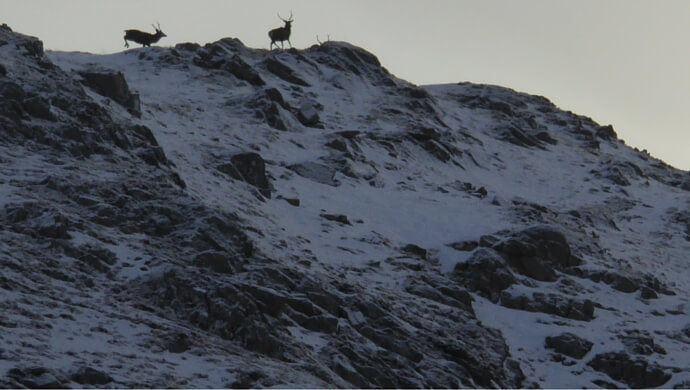
Spotting deer in Glen Affric while on winter expedition in Scotland
Price: £ on application
Email: Shangri-La@scotmountainholidays.com for full information about this trip
MINIMUM GROUP SIZE: 3 PEOPLE – Private dates available. Please enquire.
Or for something slightly different
“Porridge with whisky at 9am whilst warm & dry in my sleeping bag has never tasted better!” Ric Taylor,Bristol.”
Have you ever dreamt of taking a short walk amongst a moonlit snowy wonderland. Amazingly no need for a torch! Imagine reflected flickering candle light giving way to the soft light of a winters dawn as you emerge from you snowy abode. Not a soul about! We’ll have a vast pristine winter wonderland all to ourselves. It’s a remarkable experience.
Highlights: winter skills on Cairngorm, overnight expedition to sleep in a snow cave, creation of said snow cave
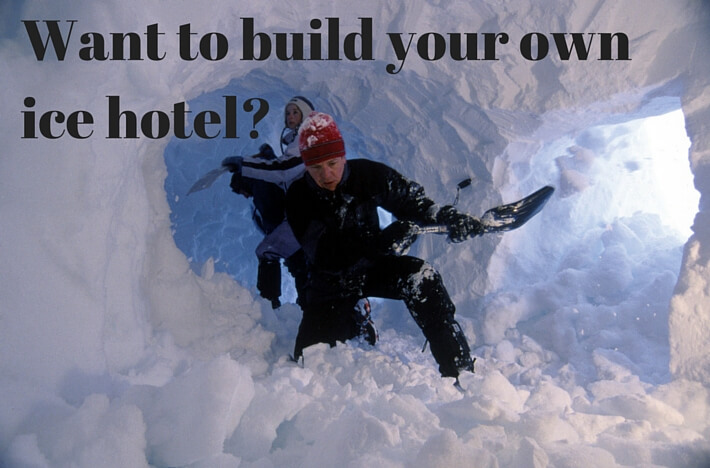
how to build a snowhole in Scotland
All digging and cooking equipment supplied by your hosts, Scot Mountain Holidays.
Check full details on the website
Highlights:
Accommodation: Barrisdale Stable (if available) or heated Tentipi
MINIMUM GROUP SIZE: 3 PEOPLE – Private dates available. Please enquire.
Highlights:
Accommodation: Barrisdale Stable (if available) or heated Tentipi
MINIMUM GROUP SIZE: 3 PEOPLE – Private dates available. Please enquire.
It’s all in vogue these days. As our normal lives become more and more sedentary, there’s an increasing emphasis on keeping fit. As we get older too, it becomes increasing difficult to maintain our fitness levels. We can’t afford to hibernate over the winter. Instead of heading abroad, we can take on a new experience and continue getting out in the countryside throughout the winter months. If you find the winter weather a challenge or too scary, take a course to give you the confidence to get out walking the hills in winter.
Extra ways of burning calories while walking in winter include:
All of which you can tick when you go hillwalking in winter.
As far as anyone can tell, the “one pound on your feet equals five pounds on your back” notion originated with Sir Edmund Hillary’s successful ascent of Mount Everest in 1953. Since then, numerous studies by academic researchers and even the U.S. Army have concluded one thing on the matter: Weight on the feet is disproportionately more exhausting than weight carried on the torso.* To find out more read the links in our further reading section. Therefore walking in winter boots requires more effort and will burn more calories!
The air in winter is so much more crisp and clear than in the spring/summer months. In spring the large estates who own huge swathes of the Scottish hillside, often start to burn the heather to maintain the grouse moors. Obviously this produces a haze from the smoke which can affect visibility. In the summer the air is generally more hazy due to the humidity which then affects how far you are able to see clearly.
In the middle of winter it is possible to see 100km or more from the high hills. For example, Ben Nevis can clearly be seen from the summit of Cairngorm.
Challenge is the big buzz word these days. Have you run your first marathon? Have you participated in your first triathlon/ironman? Tough Mudder anyone? Compared with challenges like these, winter hill walking is much more accessible and something you could do every day (in season). The biggest challenge for winter hillwalking is building up your stamina when you’re also trying to hold down a full time job. Many of us have deskbound jobs these days and the closer we get to “middle-age” (our 40s and 50s) the more difficult it is to maintain fitness and stamina levels. However, in the course of a week, many people find that their fitness and stamina levels noticeably improve on a guided winter hill walking trip.
On a typical winter walking day out with Andy, the guests record steps in excess of 30,000 per day! You’d be well on your way to your #Walk1000miles at that rate.
Sharing is a major part of walking. People tend to chat as they walk in a group and often end up discussing all manner of topics; setting the world to rights. When you share an interest (i.e. walking) already with the people you’re with, chances are you have topics in common you can discuss without coming to blows. Of course, camaraderie is not something which is confined to winter, but there is something about pitting your skills against the environment which pulls your group together and gives you something to share.
It doesn’t matter what sport you’re enthusiastic about, people love to talk about their gear and share their experiences of using it. When it comes to winter walking, if you’re a novice, you will need to make some investments to upgrade from your summer/autumn walking equipment in order to be safe in the winter hills. If you’re not sure it’s going to be your thing (though if you already enjoy walking, you might get hooked quite easily), you can always hire the technical stuff – winter grade boots, ice axe and crampons, before making the leap yourself into buying the kit.
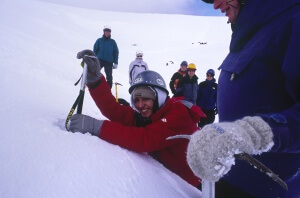 Ice axe arrest on a winter skills course
Ice axe arrest on a winter skills courseSliding around in the snow with a sharp tool – sliding down a hill on your bum – digging in the snow – kicking into ice with crampons – all become legitimate “skills” when you’re on a winter course learning the “personal safety skills” of safe movement on the winter hills.
To go out walking you don’t need to pay for a lift pass for every day you want to go up the hills.
You don’t need to buy the skis and generally you’re further away from the ski lodges, so you don’t have access to the cafes and restaurants, which means you have far fewer opportunities to spend your hard earned pennies.
Gaining new skills and becoming proficient in using them builds confidence not only in the activity you are doing, but also in other areas of your life. It is always a good idea to keep your brain active and to learn new things, particularly if you are also learning new physical skills which will help your body remain fit as well as your brain.
If you’re a novice or if you’re lacking time to gain the skills yourself, remember that winter is harsh environment and not everyone has the experience to head up into the mountains but there are plenty of local, highly-qualified guides who are very happy to take you out.
It’s much more fun to share unusual experiences with your friends. Most people like to see images and videos of adventurous activities, spectacular views, mountains, nature – you can tick all these boxes when you record your experiences out and about in the winter hills, then share then on your favourite social media channel. You’re virtually guaranteed some interaction with your friends/followers.
*A pound on the foot – the science
The Great Outdoor Forum (Stack Exchange) – discussion on the science behind extra weight on your feet.
January 2018 has been a very busy month which Andy is currently rounding off with (another) snowhole trip into the gale-bound Cairngorms with a team from the BBC Travel Show. Nerves were displayed by the newbies presenting the programme. I think they were daunted by the Triathlon enthusiasts who’d been drafted in to help dig.
We welcomed in 2018 in the company of our select winter walkers. The group all brought in the New Year with a great deal of good-humoured and crowded dancing in the street in Grantown on Spey. Dancing was followed by a magnificent firework display. Great fun for everyone which topped off some fabulous snowy walks.
Andy was even able to get out the tentipi and show off it’s capabilities over a cosy whisky in the evening. His market research (which might be skewed by the whisky and warmth inside the tentipi) shows some demand for his pony wilderness glamping proposals.
5 younger enthusiasts joined us on January 1st for the first winter skills and navigation course of 2018. We think the photos tell most of the story. Great fun and quantities of cake kept everyone happy throughout.
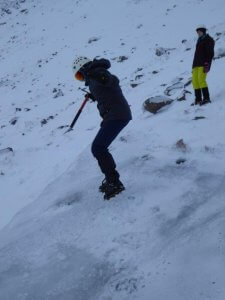 Practising cramponing techniques in the Cairngorms, Scotland. There’s nothing more fun than legitimate play in the snow.
Practising cramponing techniques in the Cairngorms, Scotland. There’s nothing more fun than legitimate play in the snow.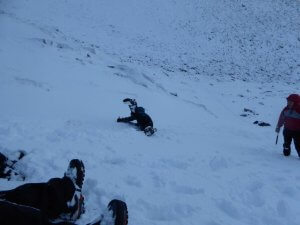 Tumbling down the mountain, alternatively known as ice axe arrest on a 5 day winter skills course with Scot Mountain Holidays
Tumbling down the mountain, alternatively known as ice axe arrest on a 5 day winter skills course with Scot Mountain Holidays
Back for some more trailbreaking through the snow-decked Cairngorms. Our blog advice on how to keep your hands warm and how to keep your phone going in the cold were of great help this week.
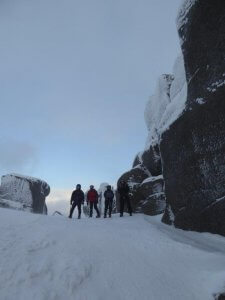 Atop Bynack Mor deep in the heart of the Cairngorms National park. Not everyone goes on to see these magnificent “barns”. Quite a feat of climbing to get to the top, especially after the walk in!
Atop Bynack Mor deep in the heart of the Cairngorms National park. Not everyone goes on to see these magnificent “barns”. Quite a feat of climbing to get to the top, especially after the walk in!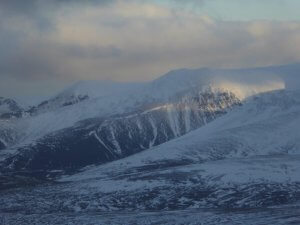 The view you’d be rewarded with for the challenge of pitting yourself against potentially the worst conditions nature can throw at you. When you come out on top, you can feel the adrenaline.
The view you’d be rewarded with for the challenge of pitting yourself against potentially the worst conditions nature can throw at you. When you come out on top, you can feel the adrenaline.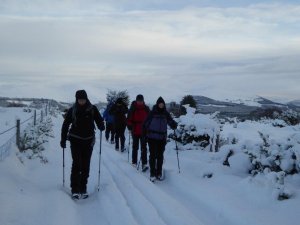 Walking through the snow – January 2018. Winter walking is a completely different experience and a different challenge. If you haven’t tried it, maybe this is your time.
Walking through the snow – January 2018. Winter walking is a completely different experience and a different challenge. If you haven’t tried it, maybe this is your time.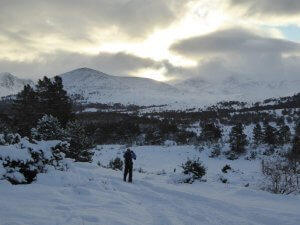 Cairngorms (January 2018) Spectacular views are the reward for challenging yourself to a winter extravaganza.
Cairngorms (January 2018) Spectacular views are the reward for challenging yourself to a winter extravaganza.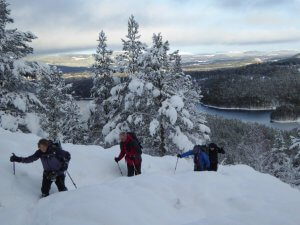 Getting a workout through the snow in the glorious outdoors. Plenty of fresh air and stunning views.
Getting a workout through the snow in the glorious outdoors. Plenty of fresh air and stunning views.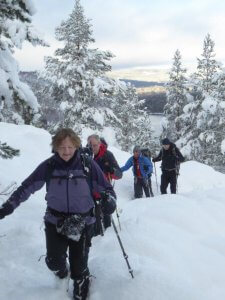 Glorious winter walking on the Classic Winter Cairngorms week with Scot Mountain Holidays this January (2018)
Glorious winter walking on the Classic Winter Cairngorms week with Scot Mountain Holidays this January (2018)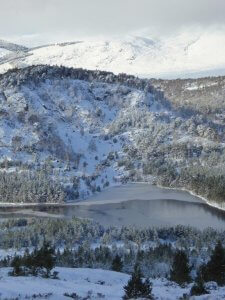 Lucky or what? The views of the Classic Winter Cairngorms week were stunning at times as this shot shows.
Lucky or what? The views of the Classic Winter Cairngorms week were stunning at times as this shot shows.Lorna chose to encourage her friends and family to join her on a Snow Hole Expedition with Andy to celebrate her 50th birthday. We felt honoured. Lorna herself must have enjoyed the experience because she’s back right now helping the BBC to dig in tonight. Let’s hope they get to see the blue moon despite the snow showers.
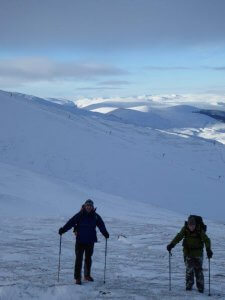 Heading out into the Cairngorms fully prepared for a night out on a Snow Hole Expedition with Andy Bateman
Heading out into the Cairngorms fully prepared for a night out on a Snow Hole Expedition with Andy Bateman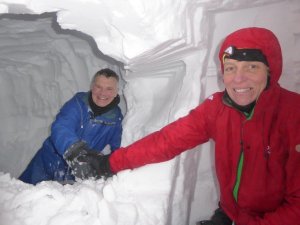 Lorna is enjoying the break through moment. Now they can see that their overnight residence is a real possibility
Lorna is enjoying the break through moment. Now they can see that their overnight residence is a real possibility
If you’d like to join us for a winter walking extravaganza or to learn new winter skills, there’s still plenty of time. Winter in the Highlands lasts well into March and sometimes even April.
Plenty of choice of walking holiday or skills course
Winter is when the Scottish hills mutate into proper mountains which need as much respect as 8000m peaks in the Himalayas. Every year there are reports of people going missing or dying in the Scottish hills. Though most people don’t realise it, it is relatively common for avalanches to go off in Scotland as well as in the Alps. Anywhere you find snow and steep slopes, there could be avalanches. Before you consider going out in winter you do need to be aware of the additional hazards and take them into consideration when making your plans. It is sensible to think of booking a winter walking guide.
If you are thinking about starting some winter walking it is extremely important to make sure you get some safety training. There are always deaths in the hills in winter. Safety training is not a guarantee that you will never have an accident but it does minimise the risk. It is important to realise though that as with all skills, you must practise. If you don’t, then the skill won’t be useful to you. For example:
on a winter skills course in the UK you are always taught “ice axe arrest” as one of the skills you will need to prevent a sliding fall. Can you imagine slipping on ice on a mountainside? The speed you achieve in a very short space of time will amaze you. Reaching for your ice axe and using it the correct way, needs to be instinctive. This takes practise as does assessing snow and ice conditions and knowing the local terrain.
Planning to go out winter walking? You’ll need to book a skills course or a guide to make a start.
Qualifications to look for:
If you are considering hiring a guide/leader you need to make sure that they have one of the following qualifications:
Winter Mountain Leader (WML) – lead groups of hill walkers in winter conditions
Mountaineering Instructor Certificate (MIC) – instructing the skills of snow and ice climbing
British Mountain Guide (BMG) – required to guide climbing (including the coaching of lead climbing) skiing and mountaineering on rock, snow & ice, and in alpine terrain
Unless you are yourself, considering leading groups in the winter mountains, there is no need to go to the extent of committing yourself to this level of training. The courses take a commitment of months or years and previous training. For pleasure, you would only need to consider a winter skills course or winter mountaineering course, which can be provided by the above instructors.
A skills course is not the solution for everyone. After all, just learning the technical skills is not the learning journey, you still need to know how to deal with the added challenge of navigating in winter. Many people prefer the security of taking a winter walking guide because of the added challenges of the winter weather.
Scot Mountain Holidays delivers a series of winter walking holidays, expeditions and challenges. We can also arrange a private winter walking guide for you (and your group) if you are unable to join an organised group.
New Year Winter Walking – Classic Winter Cairngorms – Winter Munros – Glencoe Munros –
Snow Hole Expedition – Cairngorm 4000ers – Winter Affric Shangri La – Knoydart Winter Wilderness Expedition –
The main difference between our 2 winter skills courses is that there is not enough time on the 2 day course to cover the essential skill of winter navigation. We do run a separate winter navigation course over 2 days.
2 day winter skills course – 5 day winter skills course
If our dates or our format doesn’t suit you please use our directory below to find a course or holiday which suits your requirements
Across Scotland – CnDo Scotland or Wilderness Scotland
In the Cairngorms – Talisman Mountaineering or Tarmachan Mountaineering or Cairngorm Treks or Cairngorm Adventure Guides
On the west coast – West Coast Mountain Guides or Martin Moran guiding or Abacus Mountain Guides
What a week of Guided winter walking in Scotland – almost 4 seasons in one week! From full whiteout blizzard to stunning views for miles from the summit of Braeriach, enhanced by a broken spectre with 2 silhouettes in the middle.
From conditions like this:
To glorious views like this:
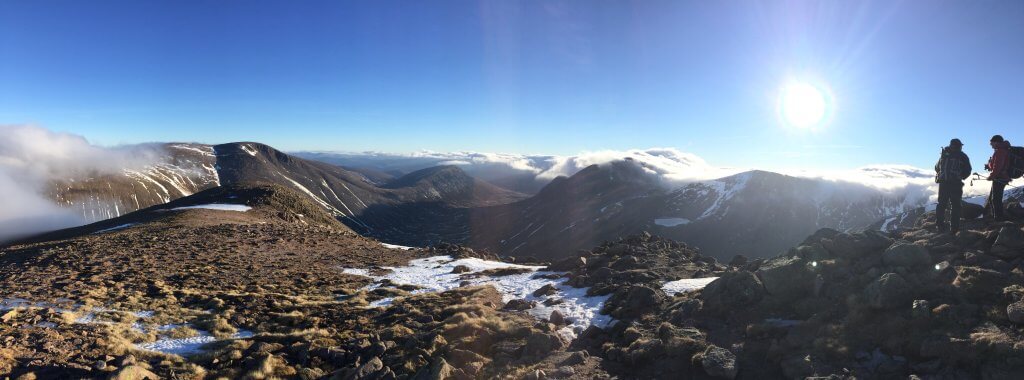 Stunning views to compensate for the lack of snow cover in the Cairngorms (courtesy of Claire Grogan)
Stunning views to compensate for the lack of snow cover in the Cairngorms (courtesy of Claire Grogan)
The weekend at the beginning of the trip offered the worst of the weather, but unfortunately if you have to get back to work … maybe next time those who couldn’t stay on will be treated to views similar to those from Braeriach at the end of the week.
“Thank you again for a very enjoyable week. Andy’s knowledge of the mountains and of the geology, flora and fauna, together with the welcoming and homely atmosphere and Rebecca’s cooking makes for a great combination”
These are just a selection of some of the points which have made the week so memorable and will hopefully serve as talking points when everyone gets home.
Group:
included
– a diverse group of individuals (including one couple) united by a common interest.
We saw a vole and it didn’t just pop out and disappear; it stayed and snuffled around searching for food. We have a really good view of it.
Sightings of ptarmigan became quite common place as the week went on. The first was exciting but by the end of the week, we’d had at least 5 sightings. Ptarmigan sightings were exciting for one of our guests whose young grandson (under 10 years old) is a keen birdwatcher, so it was something he could share with him.
We spotted golden eagle and mountain hare in the white winter plumage.
Many a hiker would love to be treated to a broken spectre. It adds a certain “je ne sais quoi” to the day and provides a talking point. Everyone wanted to see the pics (and it certainly proved popular on our social media.
https://www.instagram.com/p/BPhU-QVhzFg/?taken-by=scotmountainholidays
Panoramic photos courtesy of Claire Grogan
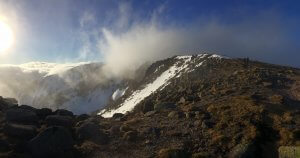 Stunning winter views in the Cairngorms highlighted by a slight wisp of cloud to add character to the picture
Stunning winter views in the Cairngorms highlighted by a slight wisp of cloud to add character to the picture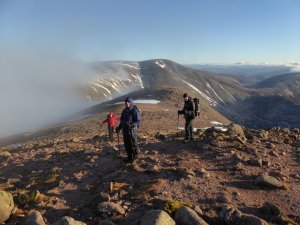 Not so wintry in the Cairngorms but still enjoying the company and repartee as the group ascends the ridges in the Cairngorms
Not so wintry in the Cairngorms but still enjoying the company and repartee as the group ascends the ridges in the Cairngorms
Check out our Facebook album for a fuller collection of the photos taken during our trip.
Lentil loaf – a great vegetarian recipe to have up your sleeve for parties/dinners with friends.
Other food: Recipes going live shortly:
Beetroot brownies
Banana and fruit loaf pudding
Grasmere gingerbread
Raspberry and pine nut bars
Tear and share tomato and cheese bread
A great group who enjoyed the variety of walking options during the week and did perhaps feel that they accomplished more in the week than they would have done without Andy’s guidance.
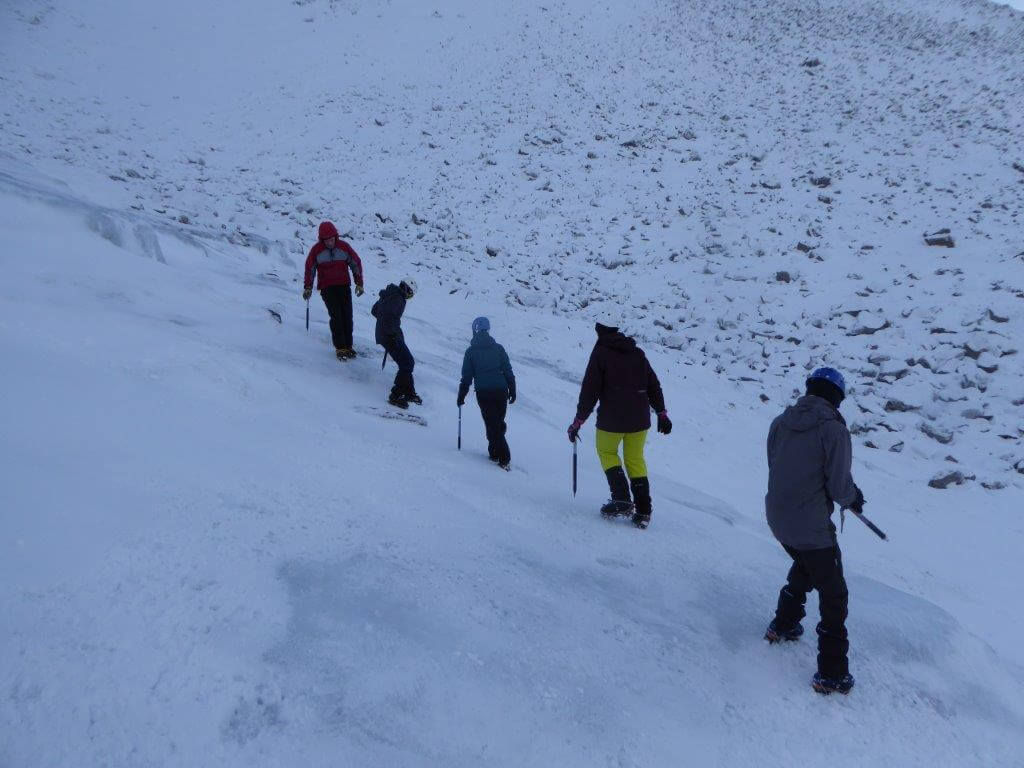
It’s now middle of November and winter in our mountains is knocking at our door. As the Atlantic storms pass our area the arctic air is drawn into their wake. With each passing front, the weather can be extremely changeable. It may be weeks yet before winter conditions are in full nick for full on winter walking, but sudden blizzards on the high tops are now common place – meaning the ill prepared can be easily caught out. Scot Mountain Holidays guide and instructor Andy Bateman takes us through some of the considerations over and above the essentials of ice axe and crampons in transitioning from autumn in winter trekking conditions.
It is prudent to carry a head torch at most times of year, but especially in the case of winter. The days are short and even a minor delay can make the difference between coming off the hill in the daylight and dark. Don’t go without!
In addition, make sure the batteries are fresh so your torch is working at full power. Carry spares too but try to avoid fumbling about to change batteries in a blizzard!
Consider upgrading your head torch to a more powerful model . Remember you may be trying to discern navigational features both in the dark and in the fog.
The stiffness of the winter boot is an integral part of ensuring crampons can be securely attached to your feet. This being said, bunging crampons is not a “fix all” and the winter boot is as much a tool on your foot as the ice axe is in your hand. You need adequate stiffness to kick steps comfortably and efficiently into hard snow. Without it, it will be difficult to execute the technique of front pointing safely.
Proper winter boots are also better insulated. If you’re thinking about buying a boot for the winter go for at least a B2. A B1 boot may be fine for a serious summer glacier trek in the Himalayas, but they don’t come up to the mark when it comes to winter in the Scottish mountains.
Check the state of your soles. It’s those sharp right angled edges that help to prevent slipping and allow you to kick steps.
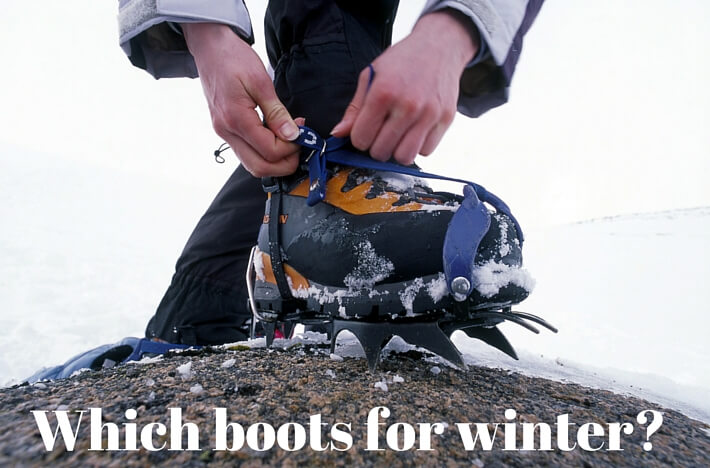
Which boots to choose for winter?
These are an absolute must and in our damp mountain climate they need to be anti-fog (double lenses). It may be uncomfortable – but not impossible – navigating into driving rain, but don’t underestimate how painful this is once precipitation turns solid. It can be literally impossible to see. Your sight is of vital importance so don’t skimp on the goggles and head torch.
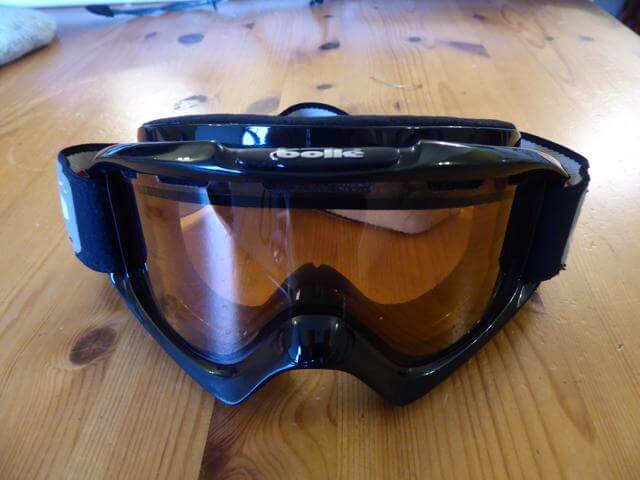
Pack that extra warm layer. The ambient temperature at 1000m rarely drops below -10 degrees C but don’t underestimate how cold it can feel. A weak winter sun, the damp air and often a high wind chill all conspire to make the British mountains one of the worst places for hypothermia. You can chill quickly when you stop moving. A really thick fleece or over layering jacket is ideal. Be cautious about wearing duvets jackets under other garments – they can loose their loft and hence insulation.
Make sure you gloves are warm enough for winter walking … i.e. they must be proper thick gloves. Not only do your hands have a very large surface area compared with their volume but also the body will reduce the circulation to them to conserve the core temperature – no wonder they get cold! So if you do have cold hands don’t just think of putting on warmer gloves, but also an extra layer on your body.
Also remember if you do particularly suffer from cold hands, mitts are better at giving you the option of adding heat pads.
If you’re coming on a winter skills course or winter walking holiday with Scot Mountain Holidays please don’t hesitate to contact Andy if you have any further questions, an expert in optimal gear.
Andy will be publishing further blogs on the subject of preparing for winter over the forthcoming weeks. Keep your eyes open!
You can also take a look at our Winter walking holidays, Winter Skills courses and Full moon Snow-hole Expedition.

In February we ran a snow hole expedition, the second of the year, in the Cairngorms.
The group was small but unusual.
Ian – our most frequent flier on the snow hole. This was his third snow hole trip. Ian first joined us in 2006 to attempt an overnight snow hole in the Cairngorms National park. The weather was against them on that trip and they had to turn back without reaching the snow hole site. The ski area wasn’t open and though the group attempted to ascend the hill they eventually had to turn back after being blown around a wee bit too much. There is video footage from their endeavours which makes for interesting viewing just to see the effect of nature, if nothing else. Ian returned again in 2007 with 90% of his group to try again – successfully
Andy – our oldest client to date on this trip – a celebration of his imminent 70th birthday.
Hui – our first guest from Singapore. A lone female traveller spending a few months in the UK on a sabbatical from her studies.
Read all about their experience in Andy’s words:

Late last year whilst at David Lloyd’s (gym), I said to my friend, Ian Thorpe, an experienced walker and climber, that I fancied carrying out some serious winter walking, but not climbing. Ian replied “Let me take you to the Cairngorms National Park, Scotland.” This was duly arranged by ian and off we set on 21st February at 10am, arriving at Fraoch Lodge in Boat of Garten, in the Cairngorms, at 16.15.
Rebecca, Andy and wee Gregor made us extremely welcome; dinner was baked salmon with a rich and wonderful sauce, followed by home made trifle containing shortbread and blackcurrants, wonderful.
Next morning, along with fellow trekker, Hui, a lady lone traveller from Singapore, we were fitted out with ice axe, crampons & helmets prior to spending our first day on the mountains practising ice axe arrest. This was a daunting experience for some one who has never even worn crampons let alone walked on ice.
Later that day we walked till late on Lurcher’s Crag and the Chalamain Gap, looking towards Corrie an Lochain, before returning to Fraoch Lodge for another wonderful dinner, having first stocked up on copious bottles of red and white wine from the local Tesco.
On Saturday 23rd February after a hearty breakfast at 7.30, we set off for the snow hole day. We arrived at Aviemore ski resort and walked in. At about 2pm we were ready to dig our snow hole. Andrew marked out 2 doorways on the ice covered mountain side. (We were about 3000ft up by now.) These door holes, roughly about 12ft apart, were then dug into using ice saws and snow shoverls. It took 2 hours to create a vertical face, then we had to further excavate in for about 5ft prior to turning inwards to join the 2 ends of the snow hole. This was particularly backbreaking work for Hui, thank God we had clear blue skies and sunshine. After about 4 more hours, the hole was completed. My feet were so cold I could hardly feel them.
Having put all our gear, including cooking utensils inside, Andrew started the evening meal. We had hot tea, followed by carrot and coriander soup, then a buckwheat and chorizo casserole. Dinner commenced about 10.30pm! Ouside the temperature was approx -9oC; inside however was relatively comfortable.

Stunning views from the “window” of your overnight accommodation deep in the heart of the Cairngorms
Next morning we woke up to a complete whiteout. My fear was how do we navigate to the summit of Cairngorm Mountain? Andrew explained that we take a direct compass bearing but because I was finding the walk hard he explained that provided we walked clearly up and around the pudding shaped mountain, we would by definition reach the summit and incidentally GB’s highest automatic weather station. After approx. 600m of ascent we duly found the summit at 1245m.
Roughly 4 hours later, we had descended back to the ski lodge. It was particularly hard going with Hui hanging on the to back of Ian’s rucksack most of the way. We had the pleasure of seeing a Ptarmigan and 2 white hares.
Overall a fabulour experience which I will not be repeating, but one to tick off. Andrew’s knowledge of the terrain, geology, weather conditions, and navigation skills were par excellence.
Having successfully returned to Fraoch Lodge, we were treated once again to an excellent farewell dinner. Many thanks Ian, Andrew and Rebecca for a memorable trip which i will not forget for a long time.
Andrew Palliser
PS My 70th Birthday on March 12th 2013 – what a perferct birthday treat to myself!
All content © Copyright Scot Mountain Holidays 2025
Responsive web design by Summit Web Solutions